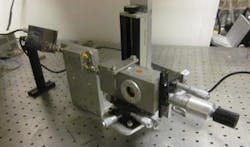New photoacoustic technique detects gases at parts-per-quadrillion level
A team of researchers at Brown University (Providence, RI) and Shandong University (Jinan, China) is detecting trace gases down to concentrations at the parts-per-quadrillion level using a new variation on the photoacoustic effect, a technique that measures the sound generated when light interacts with molecules.1
The photoacoustic effect takes place when a beam of light is absorbed by a gas, liquid, or solid, causing it to expand. The expansion is a mechanical motion that results in the launching of a sound wave. The effect was of little practical value until the invention of the laser, which, as a result of its typically narrow linewidth and high power, made photoacoustic signals large enough to be easily detectable.
Photoacoustic detectors work by illuminating a material with a laser tuned to a wavelength that is absorbed by the molecule of interest. In a typical photoacoustic experiment, the laser beam is switched on and off at a frequency that can be detected by a sensitive microphone to listen for any sound waves produced. Different molecules absorb light at different frequencies, so by adjusting the frequency of the laser, it's possible to fine-tune a detector for specific substances. So to look for ammonia in air, for example, the laser would be tuned to the specific absorption frequency of ammonia molecules. One would then illuminate an air sample, and if the microphone picks up sound waves, that means the sample contains ammonia.
But the smaller the concentration of the target substance, the quieter the signal. So the team uses an unconventional technique to boost the signal amplitude. Instead of a single laser beam, the researchers combine two beams at a specific frequency and angle. The joining of the beams creates a grating; when the laser frequencies are tuned just right, the grating travels in a detection cell at the speed of sound, creating an amplification effect at each of the peaks in the grating.
The second resonance is created by a piezoelectric crystal used in the experiment, which vibrates precisely at the frequency of the combined laser beams. The small compressive forces in the pressure waves gradually induce motion in a crystal much in the same way that small, repeated pushes of a playground swing eventually lead to a large amplitude motion of the swing.
The third resonance is generated by adjusting the length of the cavity in which the crystal is mounted so that it resonates when an integral number of half wavelengths of the sound exactly matches the cavity length. The output of the crystal, which is piezoelectric so that it generates a voltage proportional to its oscillatory motion, is sent to amplifiers and sensitive electronic devices to record the acoustic signal.
In their experiments, the researchers showed that by using those three resonances, they were able to detect the gas sulfur hexafluoride in amounts down to the parts per quadrillion.
Gerald Diebold, one of the Brown University researchers, thinks the technique will be useful in developing detectors that are sensitive to very low pollutant gas concentrations, or for detecting molecules that have weak absorptions that make them inherently difficult to detect.
Insensitive to background interference
He notes that in carrying out the experiments, he and his colleagues were "amazed to find that because the frequencies are so high (in the hundreds of kilohertz range) that there is virtually no background interference, either from electrical pickup or from acoustic sources such as room noise, wind or vibrations of a building. That means we can do experiments in an open cavity without having to block outside noise. So if you have a landfill and you're trying to detect methane, for example, you just take this detector, sit it there in the open air and continuously monitor the output."
There remains some work on engineering a compact instrument before this technique can be used outdoors, but this study offers a convincing proof of concept, the researchers say.
Source: https://news.brown.edu/articles/2017/06/photoacoustic
REFERENCE:
1. Lian Xiong et al., PNAS (2017); http://www.pnas.org/content/early/2017/06/23/1706040114
About the Author
John Wallace
Senior Technical Editor (1998-2022)
John Wallace was with Laser Focus World for nearly 25 years, retiring in late June 2022. He obtained a bachelor's degree in mechanical engineering and physics at Rutgers University and a master's in optical engineering at the University of Rochester. Before becoming an editor, John worked as an engineer at RCA, Exxon, Eastman Kodak, and GCA Corporation.

